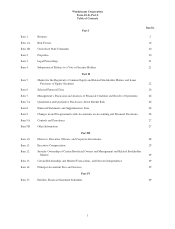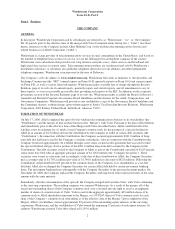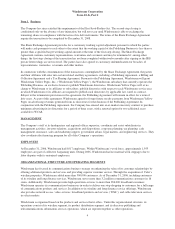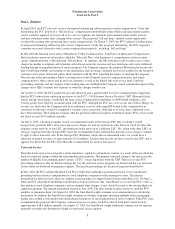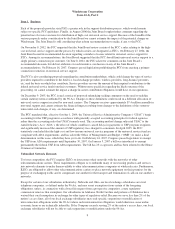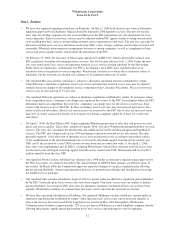Windstream 2006 Annual Report Download - page 73
Download and view the complete annual report
Please find page 73 of the 2006 Windstream annual report below. You can navigate through the pages in the report by either clicking on the pages listed below, or by using the keyword search tool below to find specific information within the annual report.
Windstream Corporation
Form 10-K, Part I
Item 1. Business
Each of the proposals provides state PSCs a greater role in the support distribution process, which would remain
subject to specific FCC guidelines. Finally, in August 2006 the Joint Board sought further comment regarding the
potential use of reverse auctions for distribution of high-cost universal service support. Because of the breadth of the
various proposals under consideration by the Joint Board we cannot estimate the impact of the potential change on
Windstream. The Joint Board is still considering what reform recommendations to make, if any, to the FCC.
On November 8, 2002, the FCC requested that the Joint Board review certain of the FCC’s rules relating to the high-
cost universal service support and the process by which carriers are designated as ETCs. On February 27, 2004, the
Joint Board issued its recommended decision regarding a number of issues related to universal service support for
ETCs. Among its recommendations, the Joint Board suggested that the FCC should limit universal service support to a
single primary connection per customer. On June 8, 2004, the FCC asked for comments on the Joint Board’s
recommended decision, but did not elaborate or reach tentative conclusions on any of the Joint Board’s
recommendations. On February 16, 2007, Congress passed legislation prohibiting the FCC from enacting a primary
connection restriction on universal service support.
The FCC is also considering proposals regarding the contribution methodology, which could change the types of service
providers required to contribute to the fund (i.e. local exchange providers, wireless providers, long-distance providers,
etc.) and the basis on which they contribute. Service providers recover the amount of their required contributions to the
federal universal service fund from their customers. Without more specificity regarding the likely outcome of the
proceeding, we cannot estimate the impact a change in carrier contribution obligations would have on our operations.
On December 9, 2005, the FCC issued a notice of proposed rulemaking seeking comments on the need to redefine
certain statutory terms established by the 96 Act. Changes to these definitions could result in a different allocation of
universal service support received by non-rural carriers. The Company receives approximately $7.4 million annually in
non-rural support and cannot estimate the financial impact resulting from changes to the definitions of the statutory
terms until such changes, if any, are determined.
The FCC mandated that, effective October 1, 2004, the Universal Service Administrative Company (“USAC”) begin
accounting for the USF program in accordance with generally accepted accounting principles for federal agencies,
rather than the accounting rules that USAC formerly used. This accounting method change subjected USAC to the
Anti-Deficiency Act (“ADA”), the effect of which could have caused delays in payments to USF program recipients
and significantly increased the amount of USF regulatory fees charged to consumers. In April 2005, the FCC
tentatively concluded that the high-cost and low-income universal service programs of the universal service fund are
compliant with ADA requirements, and has asked the Office of Management and Budget (“OMB”) to make a final
determination on this issue, which they have yet to do. On February 16, 2007, Congress passed legislation to exempt
the USF from ADA requirements until September 30, 2007. On January 5, 2007 a bill was introduced to exempt
permanently the federal USF from ADA requirements. The bill has 23 co-sponsors and has been referred to the House
Commerce Committee.
Unbundled Network Elements
To foster competition, the FCC requires ILECs to interconnect their networks with the networks of other
telecommunications carriers. These requirements obligate us to unbundle many of our existing products and services
into network elements to make them available to other telecommunications companies at wholesale rates. Furthermore,
ILECs are obligated to allow other telecommunications carriers to place network equipment on their premises for the
purpose of exchanging traffic and to compensate one another for the transport and termination of calls on one another’s
networks.
Except for certain of our subsidiaries in Kentucky, Nebraska and Ohio, our local exchange subsidiaries are rural
telephone companies, as defined under the 96 Act, and may assert exemptions from certain of the foregoing
obligations, unless, in connection with a bona fide request from a prospective competitor, a state regulatory
commission removes that exemption. Our subsidiaries in Alabama, North Carolina and portions of Oklahoma have
waived their rural exemptions in exchange for other types of regulatory relief. Because we serve less than 2% of the
nation’s access lines, all of our local exchange subsidiaries may seek specific suspensions or modification of
interconnection obligations under the 96 Act where such interconnection obligations would otherwise cause undue
economic harm or are technically infeasible. If the Company exceeds serving 2% of the nation’s access lines, our local
exchange subsidiaries will not be able to seek suspensions or modifications under the 96 Act.
9




